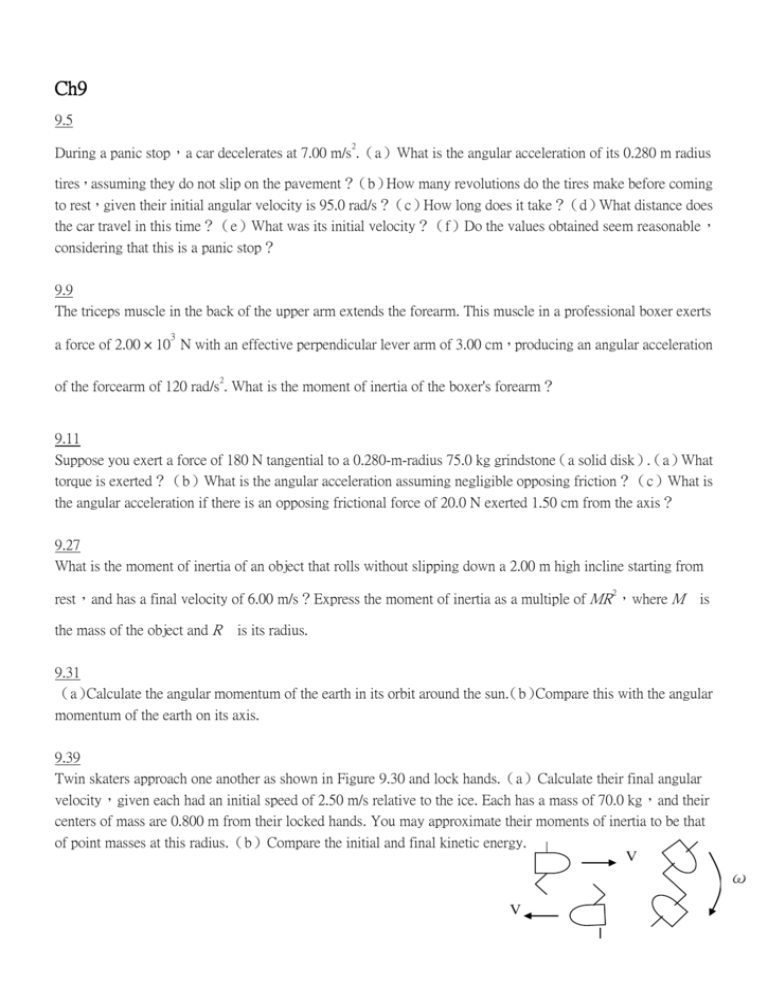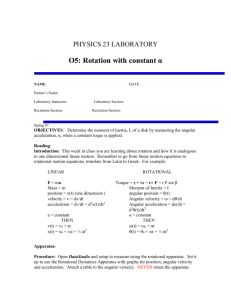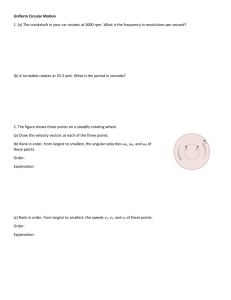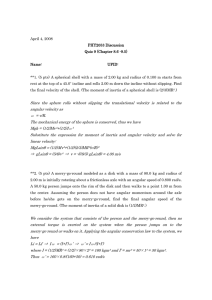Physics Exercises: Rotational Motion, Fluids, Thermodynamics
advertisement

Ch9 9.5 2 During a panic stop,a car decelerates at 7.00 m/s .(a)What is the angular acceleration of its 0.280 m radius tires,assuming they do not slip on the pavement?(b)How many revolutions do the tires make before coming to rest,given their initial angular velocity is 95.0 rad/s?(c)How long does it take?(d)What distance does the car travel in this time?(e)What was its initial velocity?(f)Do the values obtained seem reasonable, considering that this is a panic stop? 9.9 The triceps muscle in the back of the upper arm extends the forearm. This muscle in a professional boxer exerts 3 a force of 2.00 × 10 N with an effective perpendicular lever arm of 3.00 cm,producing an angular acceleration 2 of the forcearm of 120 rad/s . What is the moment of inertia of the boxer's forearm? 9.11 Suppose you exert a force of 180 N tangential to a 0.280-m-radius 75.0 kg grindstone(a solid disk).(a)What torque is exerted?(b)What is the angular acceleration assuming negligible opposing friction?(c)What is the angular acceleration if there is an opposing frictional force of 20.0 N exerted 1.50 cm from the axis? 9.27 What is the moment of inertia of an object that rolls without slipping down a 2.00 m high incline starting from 2 rest,and has a final velocity of 6.00 m/s?Express the moment of inertia as a multiple of MR ,where M is the mass of the object and R is its radius. 9.31 (a)Calculate the angular momentum of the earth in its orbit around the sun.(b)Compare this with the angular momentum of the earth on its axis. 9.39 Twin skaters approach one another as shown in Figure 9.30 and lock hands.(a)Calculate their final angular velocity,given each had an initial speed of 2.50 m/s relative to the ice. Each has a mass of 70.0 kg,and their centers of mass are 0.800 m from their locked hands. You may approximate their moments of inertia to be that of point masses at this radius.(b)Compare the initial and final kinetic energy. V ω V Ch10 10.19 2 The aqueous humor in a person's eye is exerting a force of 0.300 N on the 1.10 cm area of the cornea.(a)What pressure is this in mm Hg?(b)Is this in the normal range for pressures in the eye? 10.30 2 (a)Convert normal blood pressure readings of 120 over 80 mm Hg to N/m using the relationship for pressure 2 due to the weight of a fluid(P =hρg)rather than a conversion factor.(b)Convert these pressures to 1b/in . (c)Discuss why blood pressure for an infant could be smaller than for an adult. Specifically consider the smaller height to which blood must be pumped. 10.43 Bird bones have air pockets in them to reduce their weight---this also gives them an average density significantly less than that of the bones of other animals. Suppose an ornithologist weights a bird bone in air and in water and finds its mass is 45.0 g and its apparent mass when submerged is 3.60 g(it is watertight).(a) What mass of water is displaced?(b)What is the volume of the bone?(c)What is its average density? 10.57 -4 3 (a)The pressure inside an alveolus of radius 2.00 × 10 m due to its fluid-lined walls is 1.40 × 10 Pa. Assuming the alveolus acts like a spherical bubble,what is the surface tension of the fluid?(b)Identify the likely fluid.(You may need to extrapolate between values in Table 10.3.) 10.61 -5 We stated in Example 10.12 that a xylem tube is of radius 2.50 × 10 m. Verify that such a tube raises sap less than a meter by finding h for it,making the same assumptions as in the example. 10.75 A full-term fetus typically has a mass of 3.50 kg.(a)What pressure does the weight of such a fetus create if it 2 rests on the mother's bladder,supported on an area of 90.0 cm ?(b)Convert this pressure to mm Hg and determine if it alone is great enough to trigger the micturition reflex(it will add to any pressure already existing in the bladder). Ch11 11.5 (a)As blood passes through the capillary bed in an organ,the capillaries join to form venules(small veins). If the blood velocity increases by a factor of 4.00 and the total cross-sectional area of the venules is 10.0 2 cm ,what is the total cross-sectional area of the capillaries feeding these venules?(b)How many capillaries are involved if their average diameter is 10.0 μm? 11.21 (a)What is the pressure drop due to the Bernoulli effect as water goes into a 3.00 cm diameter nozzle from a 9.00 cm diameter fire hose while carrying a flow of 40.0 L/s?(b)To what maximum height above the nozzle can this water rise?(The actual height will be significantly smaller due to air resistance.) 11.29 3 A glucose solution being administered with an IV has a flow rate of 4.00 cm /min. What will the new flow rate be if the glucose is replaced by whole blood having the same density but a viscosity 2.50 times that of the glucose?All other factors remain constant. 11.31 The arterioles(small arteries)leading to an organ,such as the visual cortex of the brain,constrict in order to decrease flow to the organ. To essentially shut down an organ,blood flow is reduced to 1.00% of its original value. By what factor did the radii of the arterioles constrict? 11.45 Calculate the Reynolds numbers for flow in the hose and nozzle considered in Example 11. 2 to determine if the flow in either can possibly by laminar. 11.53 Oxygen reaches the veinless cornea of the eye by diffusing through its 0.500 mm thick tear layer. How long does it take the average oxygen molecule to do this? Ch12 12.37 6 3 (a)In the deep space between galaxies the density of atoms is as low as 10 /m ,and the temperature is a frigid 3 2.7 K. What is the pressure?(b)What volume in m is occupied by 1 mol of gas?(c)If this volume is a cube,what is the length of its sides in kilometers? 12.47 235 There are two important isotopes of uranium--- U and different atomic masses. Only 235 UF6 and U;these are nearly identical chemically but have 235 U is very useful in nuclear reactors. One of the techniques for separating them υrms is based on the different average velocities masses for 238 of uranium hexafluoride gas,UF6.(a)The molecular 238 UF6 are 349.0 and 352.0,respectively. What is the ratio of their average velocities?(b)At what temperature would their average velocities differ by 1.00 m/s?(c)Do your answer in this problem imply that this technique may be difficult? 12.57 3 2 Table 12.4 gives the vapor pressure of water at 40.0℃ to be 7.34 × 10 N/m . Using the ideal gas law, 3 calculate the density of water vapor in g/m that creates a partial pressure equal to this vapor pressure. The 3 result should be the same as the saturation vapor density at that temperature(51.1 g/m ).











